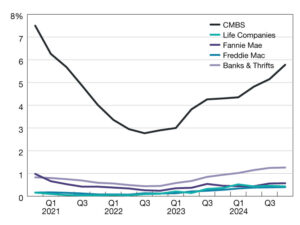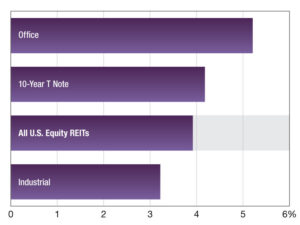3 Sectors for Savvy Investors to Watch
Volatility in financial markets, interest rate uncertainty and persistently high inflation dampened investor appetite for real estate in 2023, delaying a long-anticipated recovery in the sector. Investment volumes were down vs. long-term averages and pricing became difficult to gauge. Lessees tightened their belts as corporate margins were squeezed, and consumer spending was reined in as inflation remained persistently high. Heading into 2024, the key to success will be nimbleness and asset selection. We expect the new year to be less uncertain and less volatile than 2023. In particular, there are three real estate sectors we are paying close attention to this year: residential, mixed use and retail.
1. Residential
In both the decade preceding the pandemic and more recently, markets with strong working age population growth such as Raleigh, Atlanta, Dallas and Austin posted above-average residential rent gains, despite these markets also being characterized as cities with low barriers to new construction. In contrast, markets with high perceived barriers to supply such as the Bay Area, Los Angeles and New York City either moved to a below-average level of rent growth or remained unchanged. We believe the most attractive markets for investment over economic cycles have both household earnings growth and working age population growth.
We also believe that the current apartment market offers attractive opportunities for investors carefully selecting submarkets with attractive supply and demand fundamentals. Apartment submarkets nationwide are generally facing higher current levels of supply than historic demand growth. However, there are submarkets where near-term supply is less than historic demand growth including River Oaks in Houston, Orem and South Jordan in Salt Lake City and Forsyth County in Atlanta. All these submarkets are also located in metropolitan areas with above- average working age population growth.
2. Mixed use/office
The office sector has been challenged since the beginning of the pandemic due to work-from-home patterns. Cities where workers typically lived changed as they migrated from states like California, New York and Illinois to states such as Texas, Florida and North Carolina. A clear beneficiary of these shifts have been newer, highly amenitized assets in attractive mixed-use locations within the cities benefiting from in-migration. The cities gaining office workers from migration, which we call target growth cities, are located in an arc stretching from Seattle down through the Rockies into Texas, then to Florida and the Carolinas.
In 2023, office projects in attractive mixed-use districts within targeted growth cities gained 6 percent in total demand, and stabilized assets (those built before 2021) enjoyed an occupancy rate of more than 87 percent. Attractive mixed-use districts are quantitatively defined as areas with housing, retail and office properties in close proximity and above average rent and demand characteristics. In contrast, the U.S. average demand growth for major markets we track outside of the targeted growth cities was -1.1 percent and occupancies stood at just 83 percent at year-end 2023. We believe that as employers seek to bring people back to the office, better quality space in better locations will continue to post positive demand growth while non-premium offices, which by our definitions constitute more than 75 percent of U.S. office inventory, will continue to lose occupancy, eventually requiring them to be repurposed or demolished for other uses such as housing.
3. Retail: The return of the strip mall
The retail sector in the U.S., particularly mixed-use and strip retail formats in cities with solid population and income growth, appears well-positioned for success. Our focus for investment is in targeted growth cities with above-average in-migration and growth in the 35- to 54-year-old age cohort. These markets posted 0.7 percent average annual absorption in the strip retail space but have only 0.3 percent of strip retail under construction.
In contrast, other markets that we cover posted demand growth of just 0.1 percent over the same period, less than the 0.2 percent of inventory now underway. Remarkably, Salt Lake City, Atlanta, Seattle, Houston, Phoenix and Nashville have demand growth about three times the current construction levels and enjoy occupancies above those of the last 10 years. In addition to pandemic-driven migration, these cities offer more affordable housing and often better-rated public schools for the middle class than big coastal cities, valued qualities for the 35- to 54- year-old demographic. Conversely, the San Francisco Bay Area, Los Angeles and New York are all suffering occupancies below their 10-year average as well as new construction in line with or even higher than recent absorption rates.
To conclude, we expect more opportunities to come to the market over the next 12 to 24 months. We expect financing conditions to remain tight but begin to loosen in the second half of the year. Acquisitions need to be targeted, however, not just geographically but in terms of quality and at a sector level too. Both macro and micro lenses are necessary to take advantage of the dislocation in the market, to see through the lingering uncertainty and uncover those opportunities that may deliver strong returns including real estate that is functionally relevant now and in the future. Decisions should be guided by long-term trends supporting overarching sector choices, but the differences and opportunities within, and between sectors, subsectors, cities and submarkets will be crucial, too.
Hans Nordby is head of research & analytics, Lionstone Investments.
The post 3 Sectors for Savvy Investors to Watch appeared first on Commercial Property Executive.







Your article helped me a lot, is there any more related content? Thanks!